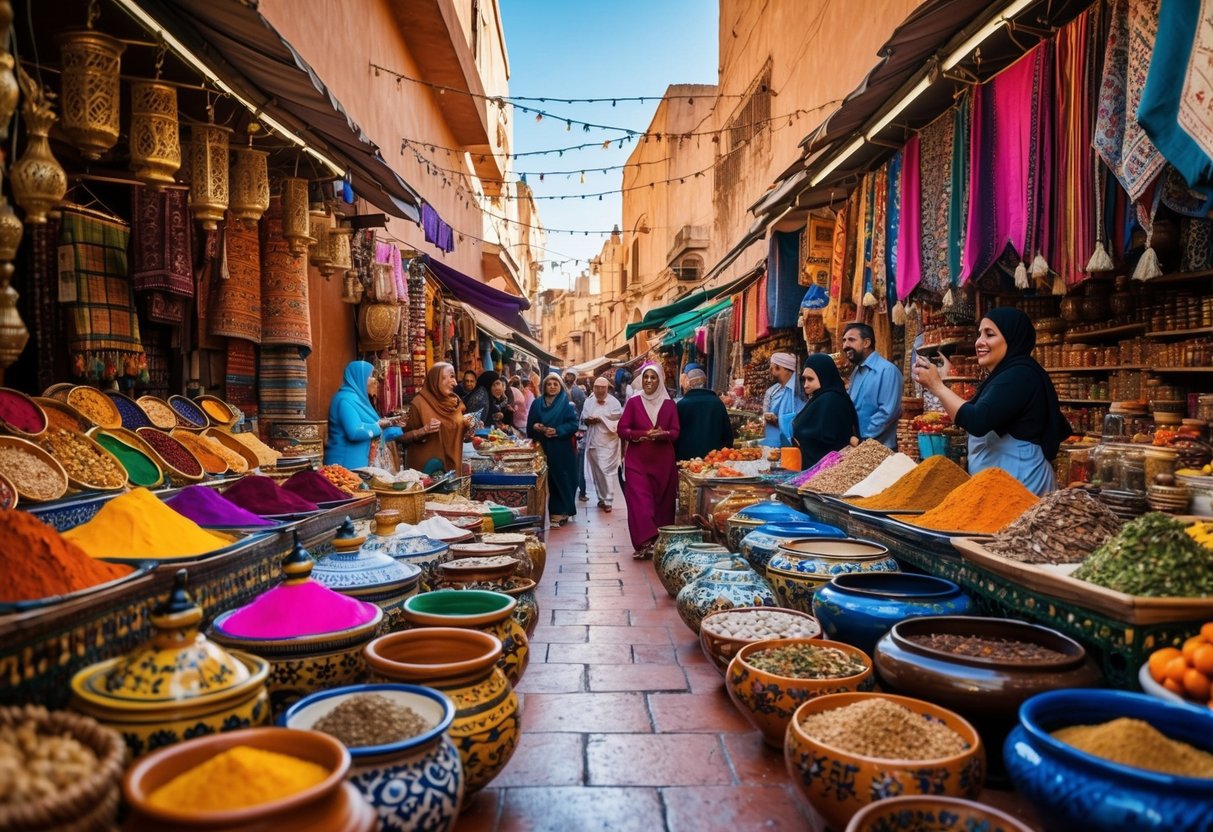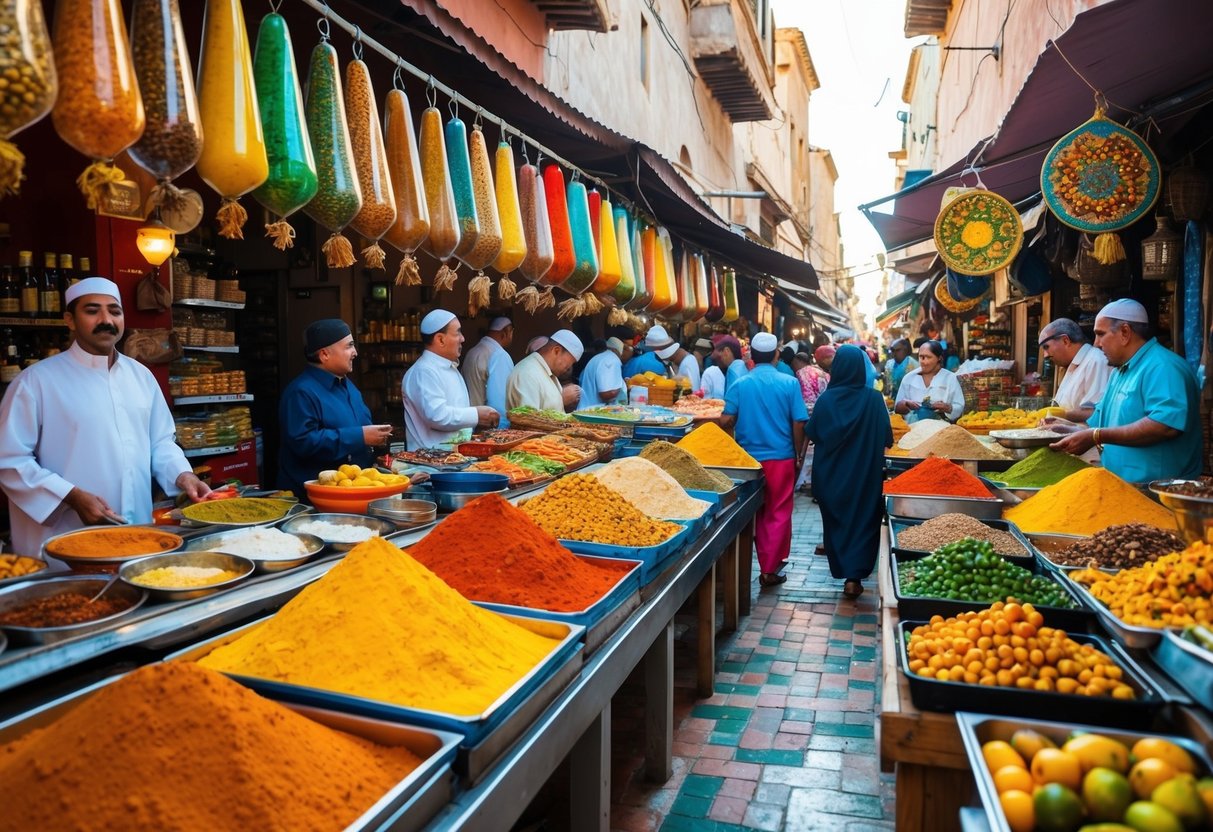
Cultural Exchange and Respect
Showing respect in the souks goes beyond knowing the language. Simple Arabic phrases like “As-salamu alaykum” (Peace be upon you) or “Shukran” (Thank you) can help build goodwill. It’s important to keep discussions light-hearted and avoid showing frustration.
It’s equally essential to respect the seller’s time and effort. Avoid making offers if there is no intent to purchase, as this can be perceived as disrespectful. Dressing modestly is recommended to show cultural sensitivity, particularly in more conservative areas of the souk.
Buyers should be aware of religious customs, such as avoiding bargaining during prayer times or major religious holidays. This enhances mutual respect and ensures a more pleasant exchange for both parties.
Culinary Delights and Gastronomy

Morocco’s rich culinary heritage is a highlight for many visitors, featuring both hearty traditional dishes and vibrant street foods. The local souks, such as Rahba Kedima, offer a multitude of options for experiencing this gastronomic wonder.
Tagine and Traditional Dishes
Tagine, a slow-cooked stew typically made with meat, vegetables, and a blend of aromatic herbs and spices, is a staple of Moroccan cuisine. It gets its name from the earthenware pot in which it is cooked, allowing for the gradual release of flavors.
Visitors can find various types of tagines in the souks, including lamb with prunes, chicken with preserved lemons and olives, and vegetable tagine. The perfect accompaniment often consists of freshly baked bread. Other traditional dishes worth trying include couscous topped with steamed vegetables and meat, and Harira, a thick, hearty soup often served during Ramadan.
Eating these dishes within the bustling environment of a Moroccan market enhances the experience, as the aromas mix with the lively atmosphere of vendors and customers.
Sampling Street Food in Rahba Kedima
Rahba Kedima in Marrakech is renowned for its diverse street food. Here, vendors serve up local favorites such as Msemen, a flaky, square-shaped flatbread often paired with honey or stuffed with savory fillings.
Another popular choice is B’stilla, a sweet and savory pie made with layers of thin pastry, pigeon meat, and spices, dusted with powdered sugar and cinnamon. Seafood lovers can enjoy freshly grilled sardines, seasoned with a blend of Mediterranean herbs.
Snack on Maakouda, deep-fried potato cakes, or try some grilled meats served on skewers, typically featuring combinations of lamb, chicken, and a variety of spices. The vibrant scene of Rahba Kedima, with its spicy scents and colorful displays, makes it an essential destination for food enthusiasts.
Textiles and Fabrics: A Colorful Tradition
Morocco’s souks showcase a vibrant array of textiles and fabrics, each with distinct colors and patterns. These markets reflect the rich heritage of Moroccan culture, where craftsmanship holds a deep-rooted significance.
Dyers’ Souk: A Palette of Colors
The Dyers’ Souk in Marrakech exemplifies a lively display of hues, where artisans specialize in dyeing textiles in rich colors. Visitors can witness the process as vibrant strands of wool hang to dry, creating a stunning visual experience. Natural dyes, derived from plants and minerals, are still used to achieve brilliant reds, blues, and yellows. This traditional dyeing method maintains the authenticity and quality of Moroccan textiles.
The Dyers’ Souk not only offers colorful wool but also finished products such as bags, scarves, and blankets. Each piece tells a story of meticulous craftsmanship, reflecting the artisans’ dedication to their art. Shoppers can take home unique, hand-dyed items that embody the essence of Moroccan market culture.
Textile Craftsmanship in Moroccan Culture
Textile craftsmanship is deeply embedded in Moroccan culture, spanning centuries. Each region in Morocco has its own weaving techniques and patterns. For instance, Berber women in the Middle Atlas mountains are known for creating intricate rugs with geometric designs and vibrant colors. These rugs are often made from wool and can take weeks to months to complete.
Hand-embroidery is another significant aspect of Moroccan textiles. Artisans skillfully adorn fabrics with detailed patterns, using techniques passed down through generations. From traditional dresses to household items, embroidered textiles highlight the cultural identity of the region. The blend of various styles and methods showcases the diversity and richness of Moroccan craftsmanship.
Moroccan textiles and fabrics provide not just functional items but also serve as cultural artifacts, offering insight into the history and traditions of the region. Each piece, be it a rug, bag, or garment, carries with it the legacy of Moroccan artisanship.